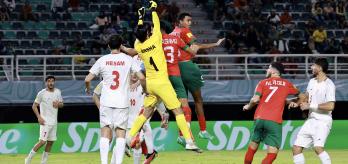An analysis of the time teams spent out of possession shows an increased use of mid/low blocks during this tournament (40%) compared to the 2019 U17 World Cup (36%). This increase can be attributed to more time being spent in low blocks, which accounted for 14% of time spent out of possession in 2019, but 18% in 2023.
It was during these phases of the game that the nature of the connection between effective centre-back pairings became particularly evident. While the number of defensive actions by central defenders per 90 minutes actually decreased in 2023 when compared to the two previous men’s U-17 competitions, it was still higher than the equivalent statistic for the FIFA World Cup Qatar 2022™. The number of successful defensive interventions was a stand-out feature of the action in Indonesia, as Technical Study Group (TSG) member Pascal Zuberbühler explains:
“Centre-backs were close [to each other] and connected, often working in the penalty area within six metres of each other”, he said. “The number of positive defensive interventions stood out for all the members of the TSG, and the relationships between the centre-backs and the defensive midfielders in all four semi-finalists were important factors in their success.”
A partnership of fluidity and awareness
The way centre-backs communicated with each other during matches was particularly notable. In the most effective centre-back pairings, the two defenders each played with an acute awareness of their partner’s role as well as their own. This awareness could be seen in the way they covered each other when one of the pair was drawn out of the defensive structure to deal with a direct threat from an opposition player.
The first clip below is a fine example of the fluid, cohesive relationship between Germany centre-backs Finn Jeltsch (4) and David Odogu (14). In their quarter-final against Spain, the World Champions’ central defensive pairing demonstrated their ability to alternate positions, allowing each other to take responsibility for the players they were marking while trusting their partner to cover any vulnerable spaces.
As Pape Thiaw points out, “Centre-backs Finn Jeltsch and David Odogu remained central in the penalty area, allowing and trusting their full-backs to deal with the threats in wider spaces. Inside [the area], both players were aware of each other’s movements and the whereabouts of opposition attackers. We see how comfortable they both were when they rotated between the left and right centre-back positions and how decisive they were in their decision-making and defensive interventions. For such young players, these levels of concentration, awareness and focus are impressive.”
Germany were not the only side whose success was built on a solid central-defensive partnership. Argentina advanced all the way to the semi-finals before finally being bested by the Germans, and this clip from their group-stage encounter with Poland shows the strength and connectivity at the heart of their defence, as Valente Pierani (13) and Thiago Laplace (16) combine to cover the central defensive space before a transition to attack that leads to a goal being scored.
The final clip provides an excellent example of positional connectivity from Japan centre-backs Kaito Tsuchiya (4) and Kotaro Honda (5) during their round-of-16 match against Spain. As a Spanish attack develops in their penalty area, the two defenders commit themselves and cover for each other before an important defensive intervention is made. Their spatial awareness and the fact they stay close to each other at all times ensure that, when the space in behind Honda is penetrated, Tsuchiya is close enough to make a crucial and perfectly-timed challenge.
SUMMARY
The working relationship between centre-backs is the fulcrum upon which successful defences are built. When defending in their final third, maintaining the right distance between the two central defenders is fundamental to their ability to provide cover for each other whenever one of them is committed to a defensive intervention or is taken out of the game by the opposition. If the defenders are too far apart, they leave vulnerable spaces that can be exploited. Working together effectively requires good communication, spatial awareness, fast decision-making and trust. These relationships can take time to coach and nurture, but when synergy and understanding builds between the two players they can become a powerful defensive unit that is more than the sum of its parts.









